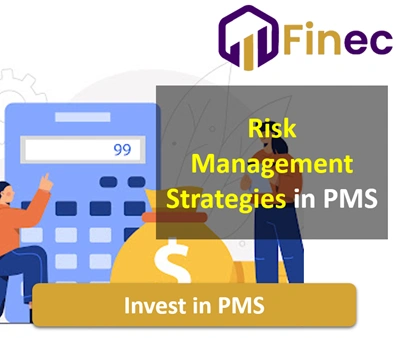Lately, people have become investment-savvy, all thanks to the growing awareness about investments. With the wealth of online knowledge, people can better understand the basics of investing.
Also, with the help of advanced financial tools, they have been learning to manage their assets more effectively. However, high-net-worth individuals have always seen portfolio management as a challenge.
So, they rely on portfolio managers to handle their investments. Having many assets is also a significant reason for them to rely on fund managers.
However, PMS has an advantage for them as it reduces risk and increases returns. Also, with PMS, investors can enjoy personalised services.
These services help investors manage their investments efficiently and without hassle. Furthermore, expert fund managers handle all investments, so investors don’t have to worry.
However, like any other investment channel, PMS also comes with risks. This article examines risk management in PMS.
By understanding risk management in PMS, investors can make informed investment decisions.
Understanding Risk Management in PMS
Before getting started, let us examine risk management in PMS. PMS is a professional investment management service offered by portfolio managers.
They study investors’ risks and financial goals and suggest appropriate investment vehicles.
Furthermore, the unique aspect of PMS is that it provides personalised services based on the client’s needs.
Risks in PMS are very common in the investment industry. Even with a professional approach, one can encounter potential risks.
However, managing them effectively is what sets PMS apart from others. By using portfolio management services, investors can significantly avoid potential risks.
Above all, dedicated fund managers can analyse and assess risks beforehand. This further helps to prevent projected losses.
For the novice, risk management involves assessing risks and optimising returns to protect the capital investment.
So, including a risk management strategy is the best possible move in the long run. This not only avoids risks but also saves investors from potential losses.
Nevertheless, few risks are unavoidable. Investors are prone to experiencing risks at some point in time.
However, effective risk management strategies can always minimise them. Let’s look at how to reduce risks in PMS.
Best Risk Management Strategies in PMS
PMS comes with a risk management strategy for novice investors. Thus, investors can stay stress-free while investing through PMS.
Here, minimising risks in PMS means investing in options that are less likely to be risky.
So, instead of investing everything in one option, the fund manager divides it among various investments.
This further avoids overall loss, even if one or two assets underperform. Risks can also be minimised by monitoring the portfolio closely.
Tools like stop-loss orders and hedging can help prevent massive losses from market fluctuations. Here are the strategies that can help you manage risk in PMS effectively. Skim through!
Proper Inquiry – Top PMS Risk Management Technique
The investor must first inquire about the PMS firm. Yes! The investor must be mindful of whom he is associating with when investing his money.
He must conduct thorough research and choose an established PMS provider. Before doing so, he can also contact current clients for feedback.
Diversification – Best Risk Management Technique in PMS
The popular step in risk management is diversification. The fund manager suggests diversifying assets to avoid risks.
Here, diversification refers to investing money in different investment vehicles rather than one option. Popular investment options include equity, debt, and hybrid investments.
By investing in these options, investors can reduce risks. Through diversification, losses from underperforming investments can be ignored.
Related Articles
| Best PMS in India | Top PMS Strategies |
| PMS Charges | What is Portfolio Management? |
| PMS Investment | Future of Portfolio Management |
Capital Allocation – Best Risk Management Strategy in PMS
Capital allocation is yet another aspect that PMS providers should focus on. It should be carried out based on the client’s risk appetite, financial goals, and changing market conditions.
The fund manager should use these factors to allot assets appropriately, another effective way to reduce risks.
Risk Budgeting – Manage Risk in Portfolio Management
Risk budgeting involves allocating and managing risks strategically. It is based on risk tolerance, financial goals, and investment strategy.
Fund managers should set risk limits before investing to avoid huge losses. This is said to be the most balanced approach to taking risks.
The fund manager also reviews the investments frequently and adjusts them accordingly.
He considers changing markets, investment performance, and investor risk tolerance and designs risk budgeting based on these factors.
Regular Monitoring – Top Risk Management Strategy in PMS
Investors should regularly monitor investments and stay aware of available options, even with a fund manager. Fund managers should also periodically monitor the investment options.
By doing so, they can quickly identify risks. That is the easy way to make informed financial decisions and meet the client’s financial goals.
Moreover, investors must stay in touch with the fund manager and regularly monitor and review the portfolios. By examining portfolio performance frequently, investors can avoid possible risks.
Cost Analysis – Mitigate Risk in PMS
Always analyse the cost of your PMS provider before signing up. The more assets you own, the more expensive the portfolio management services will be.
So, you must analyse the price and determine if you are OK with it. Also, it is essential to cross-check whether your returns and the PMS charges are validating.
In most cases, the PMS services get so expensive that they would compete with the returns generated. So, be mindful during cost analysis. Take cues from other investors and compare the costs.
Liquidity Planning – Reduce Risk in Portfolio Management
Liquidity planning is another essential aspect of risk management in PMS. The investor must find out how the portfolio management company manages liquidity funds.
Since markets often change, investors need to know how their assets are managed during these fluctuations. By doing so, they can avoid a money crisis, which could come at any moment.
Assessment of Regulatory Compliance – Risk Management Technique in PMS
Regulatory compliance is also an essential element of risk management in PMS. The fund manager must thoroughly understand and follow regulatory compliance.
This will help him manage risk effectively. Additionally, the investor must follow up with the fund manager regarding the regulations.
Investors and fund managers should note that regulatory changes can hugely affect PMS investments. Therefore, it is necessary to monitor them closely to avoid losing investments.
Use of Risk Assessment Tools – Portfolio Management Risk Reduction Technique
Using risk assessment tools is another effective way to manage risk in PMS. With the advancement of technology, these tools have come in handy.
Many prominent PMS firms have been using these tools to assess risk beforehand. The tools generally assess market risks, credit risks, etc.
So, a fund manager is recommended to use the risk assessment tools to avoid risk in PMS.
Risk Assessment
Determining the risk under various market conditions is extremely important. Sudden market crashes, recessions, etc., could occur at any time.
Therefore, assessing the risk ahead is essential for the investor. This helps the fund manager and investor respond effectively to changing market conditions.
Risk-Sensitive Returns
Portfolio managers look to invest in investment vehicles that provide potential returns. Despite the risks, investors often select options that offer higher returns for the level of risk involved.
This risk-sensitive return strategy can help manage the risks in PMS.
Why is Risk Management Important in Portfolio Management?
Here are some crucial reasons why risk management is vital in portfolio management.
- Risk management is mainly carried out to avoid capital loss. Employing various risk management strategies can prevent capital loss because of market fluctuations or recessions.
- With risk management, fund managers can make intelligent investment choices. This further helps in boosting returns.
- Effective risk management in portfolio management helps make informed decisions. Investors can effortlessly avoid risks and make high-performing investment decisions.
- The fund manager can protect the invested capital with the right risk management strategy.
- Investors can effectively reach their short-term and long-term financial goals by following a risk management routine.
- In some cases, following SEBI’s rules and regulations is a form of risk management. Besides, investors who break regulatory compliance may face challenges in their investing journey.
- With risk management, investors can avoid unpredictable situations that could bring possible losses.
- Investors can feel assured that their capital and returns are protected using a risk management strategy.
Risk Management in PMS – Conclusion
Pick one with excellent risk management services if you’re a high-net-worth individual looking for a Portfolio Management firm.
Also, check if their services are up to the mark and affordable. Examine if their approach to handling risk is sustainable.
Furthermore, ensure you partner with a top PMS provider that offers exceptional risk management services to enhance your portfolio performance.
To wrap up, risk management strategies in PMS are vital. The ultimate goal is to reduce the risk of financial loss.
The fund manager must include a risk management strategy regardless of the situation. He must design great investment solutions by effectively using risk management strategies.
While few companies use tried-and-tested strategies, few firms tailor strategies according to customers’ needs.





